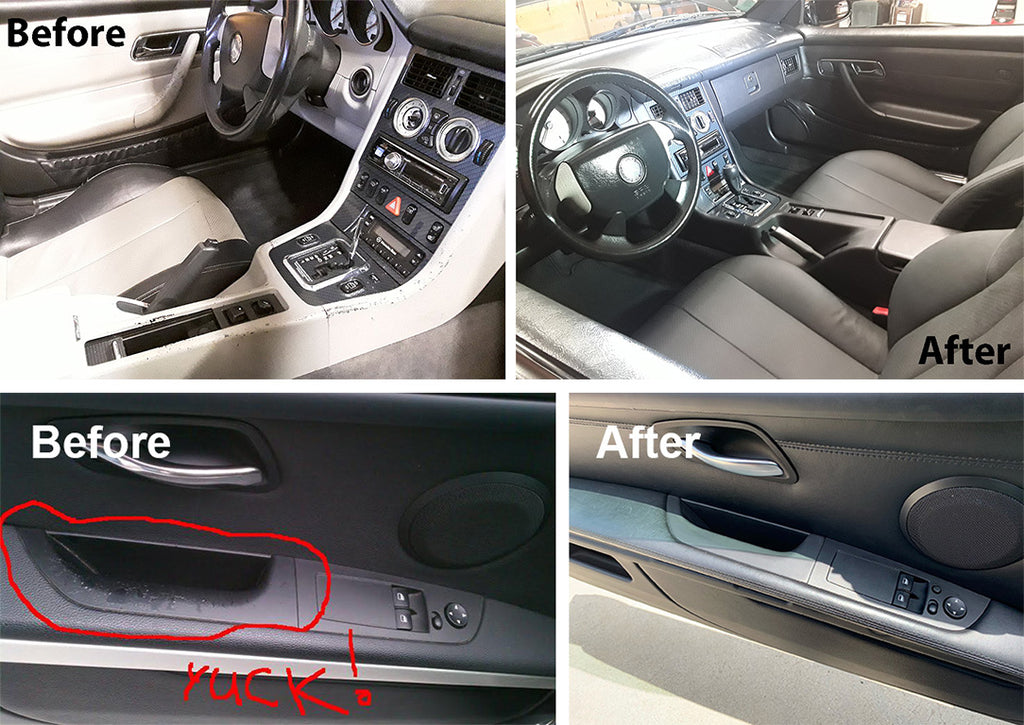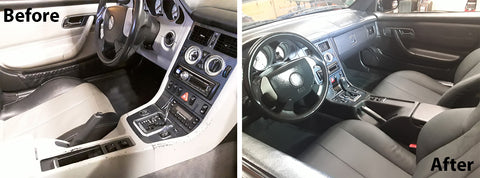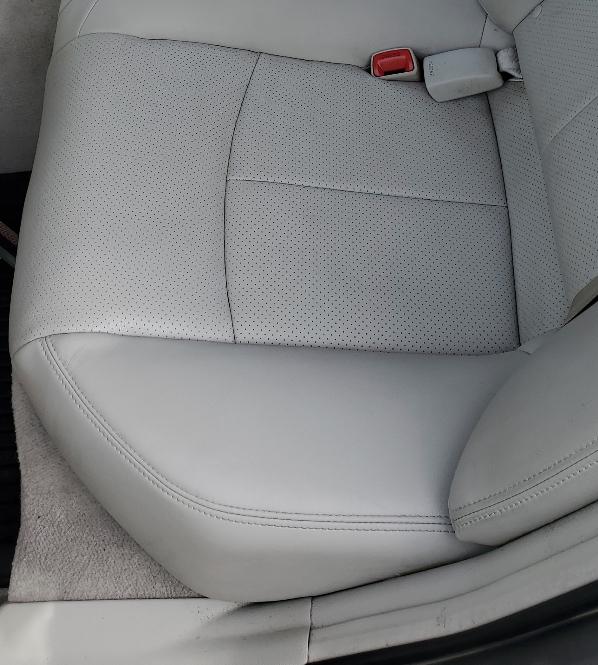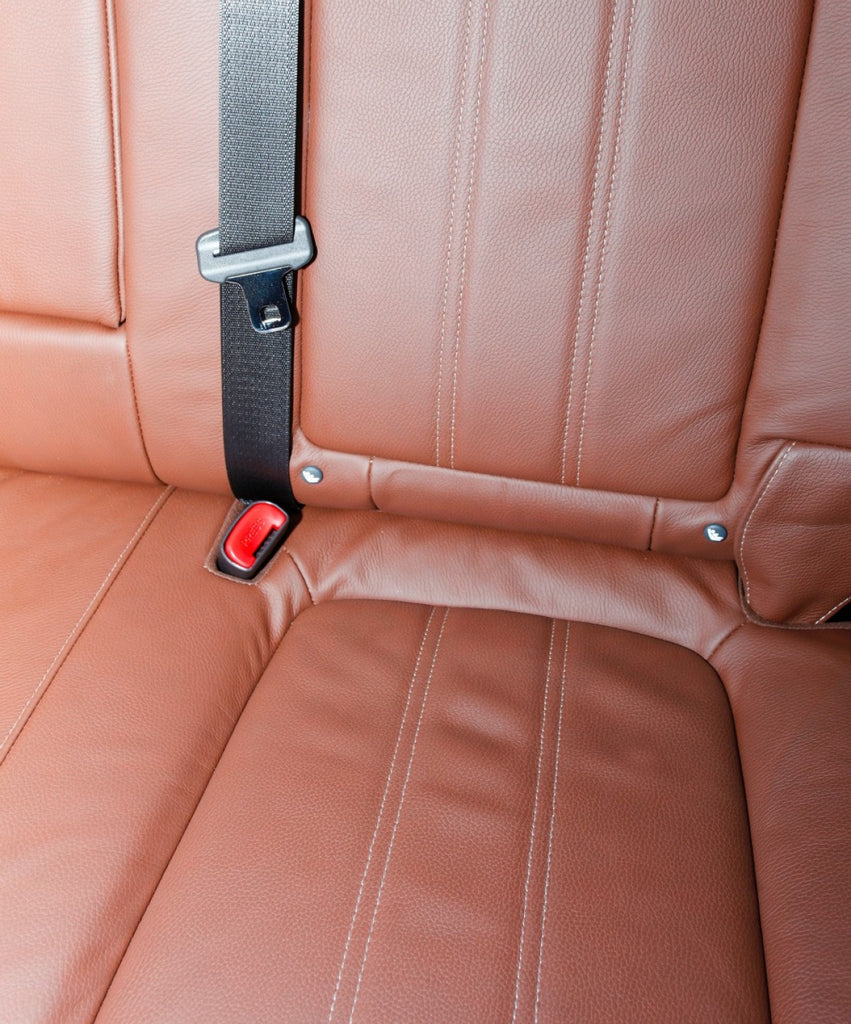
How to Fix Peeling BMW and Mercedes Interior Trim
Starting in the late 1990’s and early 2000’s German luxury car manufacturers commonly used soft-touch rubber type coatings on dashboards, door handles and other interior components. While the coating looked great when new it would often become tacky and start peeling over time. It’s not just German luxury cars that are experiencing this issue. Non-German luxury vehicles like Lexus have problems with rubber-like coatings too. Luckily, there are ways to remove the coating and restore the appearance of the trim. These procedures are sometimes covered on online forums, and often ColorBond LVP leather, vinyl and plastic paint is recommended as part of the repair process. Do-it-yourself projects relating to how to fix peeling BMW and Mercedes interior trim are brought to our attention on occasion. Check out these amazing examples of interior trim repair.
Problem: 2005-2013 BMW 3 Series Interior Door Handle Pulls Peeling

2005-2013 BMW 3 Series models have a problem with the rubber-like coating delaminating from plastic interior door handle pulls. ColorBond customer Edvin M. told us about his BMW M3, which was having the issue. He considered replacing the handle, but instead decided to use ColorBond LVP to fix the peeling BMW interior trim. The interior trim repair turned out great and was far more economical than part replacement. Here’s how he did it himself.
1. Access the Door Handle
Edvin said removing the door handle would have been a real hassle and leaving the door panel in place makes the job much easier. When this is done the window switch panel must be moved out of the way to properly access the handle to fix the peeling BMW interior trim. This was done by removing the trim strip on the door, which provides access to the panel to push it up and out. The wires were then disconnected from the switch, and it was set aside.
2. Remove the Old Coating
Next Edvin removed the rubber-like coating from the handle, which was made much easier by heating the handle with a blow dryer. Once heated he peeled off the coating with his thumb nail and a razor blade. Of note, care must be taken not to gouge the handle or door panel if a razor blade is used.
3. Proper Preparation is Key
Proper preparation before interior trim repair is key to a quality and long-lasting paint job. Once the coating was completely removed Edvin cleaned the handle with ColorBond Prep Cleaner, which removes any residues, so ColorBond LVP has the best surface for bonding. Of note, alcohol can be used if Prep Cleaner isn’t handy.
4. Mask What You Don’t Want Painted
Edvin masked off the area surrounding the door handle with paper and masking tape to protect it from overspray.
5. Adhesion Promoter
As the door handle is hard plastic Edvin prepared it with ColorBond Adhesion Promoter before applying ColorBond LVP as we recommend for best adhesion. Of note, leather, vinyl, and soft plastics do not require Adhesion Promoter. Again, proper preparation before interior trim repair is key.
6. Painting (Here comes the satisfying part)
Three coats of ColorBond LVP were applied in the correct BMW door handle color. ColorBond LVP is available in a variety of OEM Certified colors including BMW OEM colors. Now the door handle looks just like new.
To see details of Edvin’s interior trim repair project click here.
7. Less Hassle
Brad said to fix the peeling BMW interior trim he used $45.00 of ColorBond products. In comparison a replacement BMW door handle would run about $40.00 – $45.00, which isn’t much more than the products he used. The real savings was avoiding the time-consuming hassle of removing the door panel and not breaking retainer clips in the process.
Problem: 1998 Mercedes SLK 230 Rubber Coated Interior Plastics Peeling

Brad S. ran into the same peeling problem with the rubber-like coating in his wife’s Mercedes SLK 230. In this case the dash, console, glovebox, and door pulls were peeling, which is common with most all Mercedes Benz SLK models. While touch-up kits that use this type of coating are available, Brad thought “Why use the same coating that will flake off again?”.
While researching interior trim repair, Brad learned about ColorBond LVP through an upholstery shop, and decided he would use it to fix the peeling Mercedes interior trim himself. As he wanted to change the interior color from tan to black, he was immediately impressed that ColorBond offered OEM correct Mercedes interior paint colors that would give the interior an original appearance.
1. Old Coating Removal
Brad started the interior trim repair by removing the components from the car and peeling off the rubber type paint. He found using very hot water loosened the paint and allowed it to be more easily removed. Brad used a steamer (like that used to clean drapes) to lift the paint in the nooks and crannies. He also used a water filled turkey fryer to fix the peeling Mercedes interior trim. “I just made sure I turned off the flame, after the water was heated, before I put the parts in so that they wouldn’t melt”. Brad laughs. After removing the parts from the turkey fryer, they were scrubbed with water and an SOS pad to take off any remnants.
2. Cleaning the Surface
ColorBond Prep Cleaner was then used to remove any remaining dirt or oil. As a final measure, Brad wiped the parts down with alcohol to be sure any finger oil was removed.
3. Painting
Though not a recommendation of ColorBond to fix peeling Mercedes interior trim, Brad warmed the parts for five minutes in a 170° oven, and then applied ColorBond Adhesion Promoter while they were still warm. Three coats of ColorBond LVP in OEM correct #349 Mercedes Anthracite was then applied to the carpet, door panels and all the hard-plastic trim (since the seat leather was cracked, they were reupholstered). Brad said the ColorBond went on great, the results of the interior trim repair were excellent and all the textures in the plastic were as defined as before painting.
To see details of Brad’s interior trim repair project, click here.
4. Big Savings
Check out the cost of using ColorBond LVP versus replacing the interior components:
- 1 bottle ColorBond Prep Cleaner – $6.95
- 1 can ColorBond Adhesion Promoter – $20.75
- 8 cans ColorBond LVP – $186.80
Total Cost – $214.50
Replacement components from Mercedes Benz would have cost a few thousand dollars!
Peeling rubber coatings on auto interior components look horrible. However, using ColorBond LVP is an excellent way how to fix peeling BMW and Mercedes interior trim, as well as the trim on other vehicles affected by the issue.
Of note, while we were researching how to fix peeling BMW and Mercedes interior trim, we found a YouTube video by The Auto Repair Guys in which they were the interior trim repair project of restoring a door handle. We were pleased to see they were using ColorBond LVP. Check out the video and they will show you in detail how they did the job.



